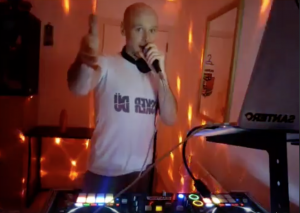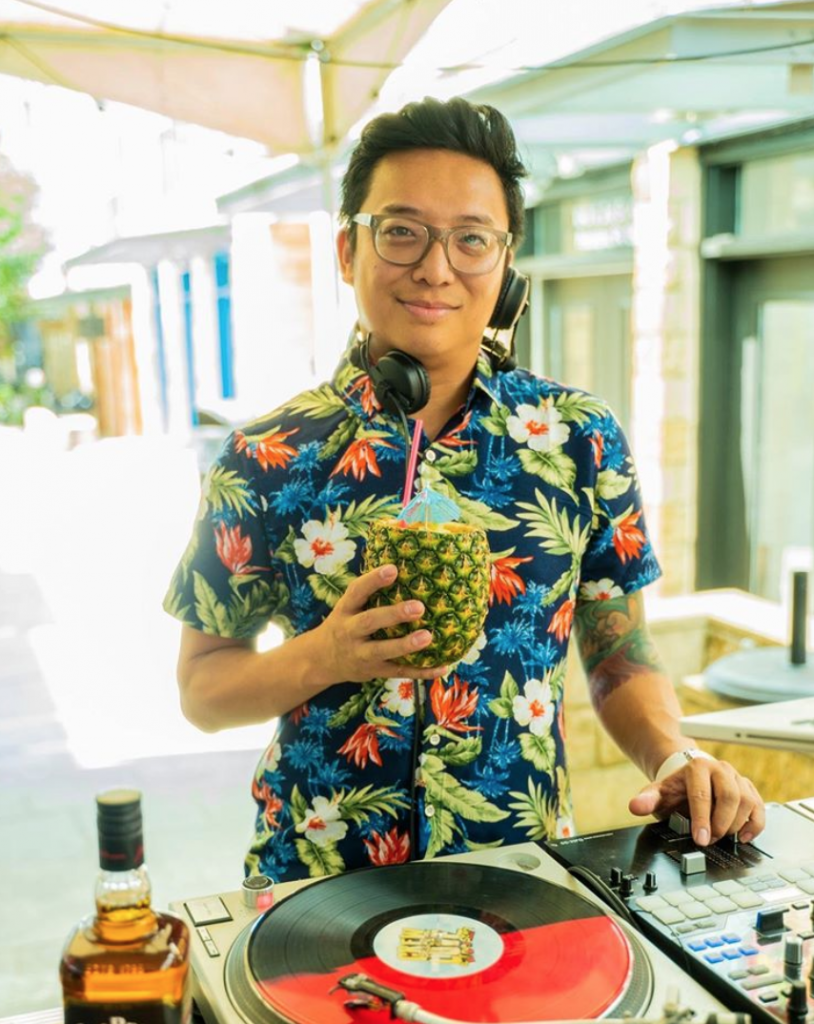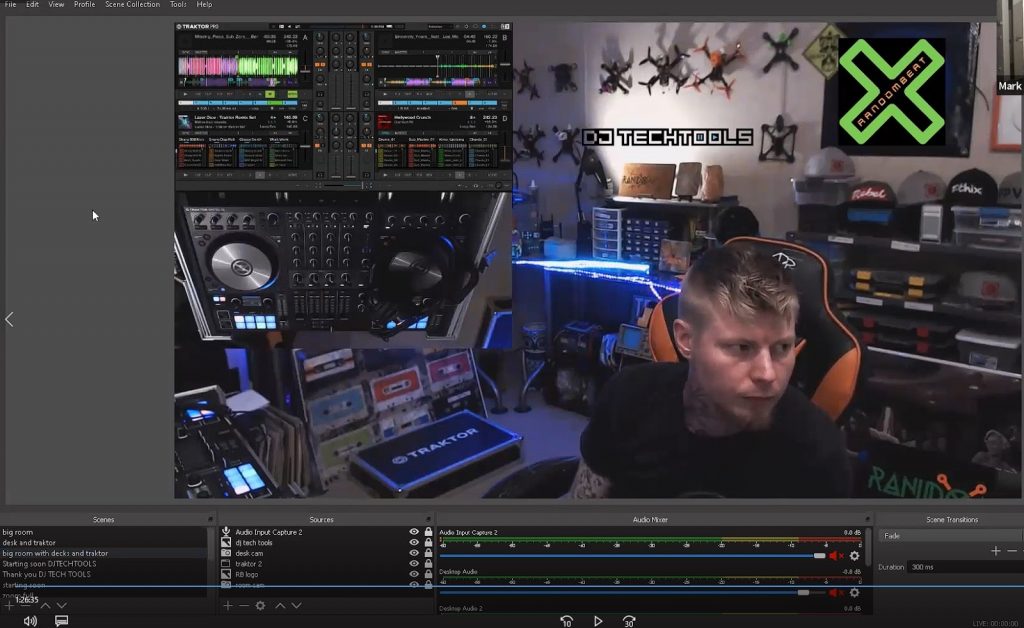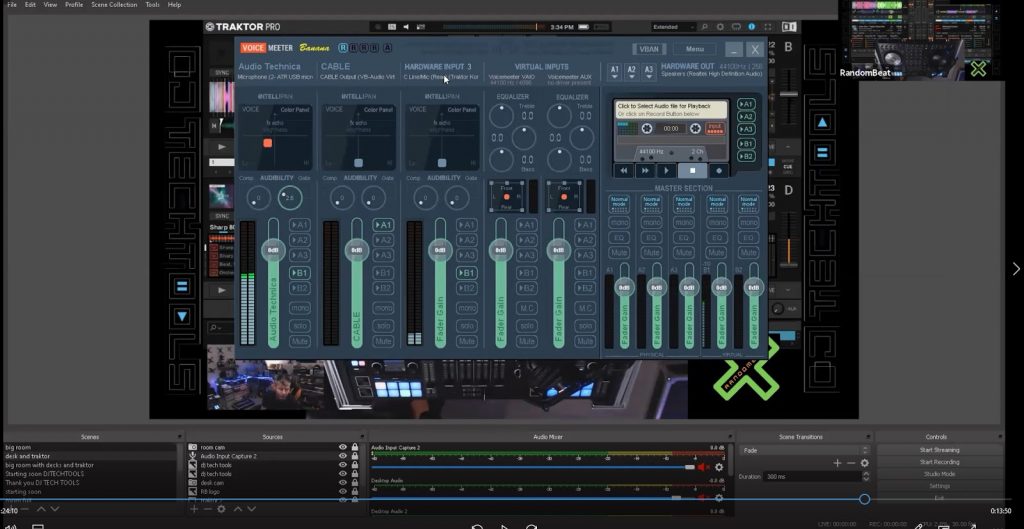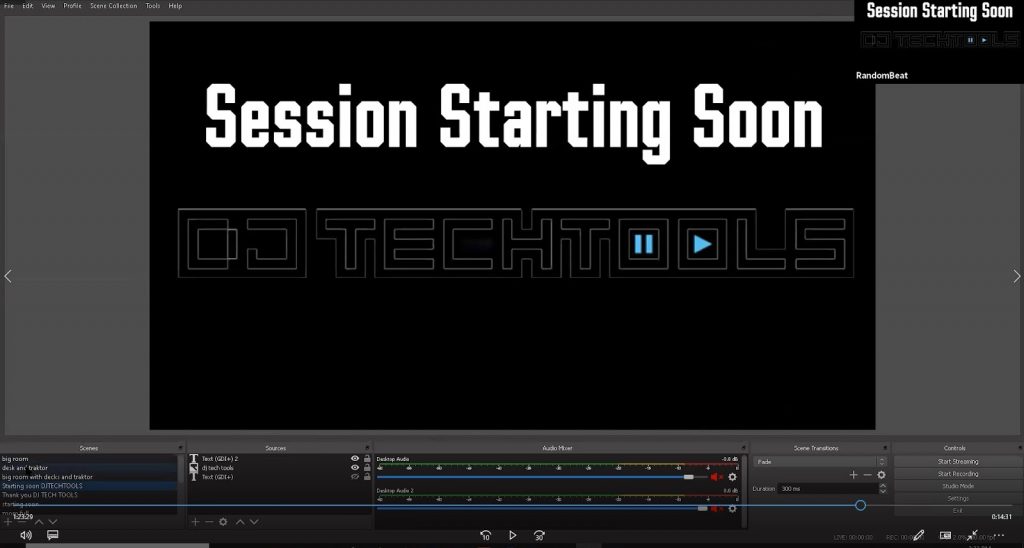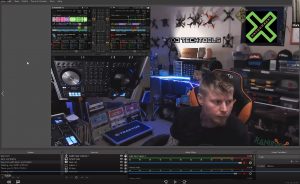
3 Examples of Livestreaming DJ Set-Ups
DJs love to share their music selections with the world, but circumstances have come together to make this a whole lot trickier in 2020. Today, I’m going to run through my super simple set-up, and speak with two DJs about their approaches to livestreaming, to give an idea of the options.
This isn’t going to be a comprehensive guide – there’s a million ways to livestream, dozens of platforms, and everyone has slightly different set-ups. I’ll link some useful resources at the end of the article, but this is more to show a few working examples, and hopefully inspire you guys to work out a way that works for you!
My set-up
I am not very technically minded, so I have a pretty simple set-up that I have seen streaming with.
I go from the XLR output of my mixer to a Behringer UMC202 soundcard – the key thing here apparently is the Core Audio that this soundcard has. From there, I output a USB cable, which is plugged into an adaptor cable to switch it from USB A to USB C – this is the one I have. From there I go into my phone – a Google Pixel 3XL, which fortunately has an incredible front-facing camera. I use a Joby stand to position it so the decks and me are in shot clearly. From there, I simply head to Instagram, Facebook, whatever. Start a live set, and away I go – a crucial thing is to make sure the master out is not very high, or else you risk distorting the signal, which sounds HORRIBLE at the listener end! I use a Shure SM58 through the mixer to chat to my viewers. I generally ask my audience how it sounds early on to be sure!
I’ve ordered a microphone stand (yet to arrive!), and some simple lights for after-dark sets, to make it all a bit more visually appealing.
So far this set-up is working really well for me – lots of people contacting me, asking how I get the sound so good. I read and respond to comments on my laptop. Speaking plenty helps keep the copyright cops at bay, and people like to get a sense of your personality, and its nice to have that human contact during a lockdown too!
Friends and fans are really enjoying me playing different stuff to the average too – I think this is a great opportunity for DJs to really explore their crates, express their personalities, and stand out from the crowd.
Kevin Kong
Can you tell us a bit about yourself?
My name is Kevin. I’ve been living and DJing in Philly since 2000. Professionally for maybe the past 6-7 years. I mostly play open format stuff these days. I’ve always been interested in video game stream son twitch, but only been personally streaming since last Monday, March 16th, the day we began our quarantine here in Philadelphia. More deets at kevinthedj.com
So what is your current streaming set-up, and how did that evolve? Why did you settle on that set-up?
I am currently DJing and streaming on a 2018 13″ Macbook Pro i5 with pretty modest specs. All the DJing, encoding, and broadcasting is done on the same MBP. Though I eventually want to do the encoding and broadcasting on a separate PC with a proper GPU. As for the peripherals, I’ve been having trouble outputting digital audio from my Pioneer S9 (the vinyl control tone is being sent to the audio out and I can’t figure out how to mute it), so I am doing the DJing on a Pioneer DDJ-SR2. I have a Shure SM58 on a mic stand, the main camera is just the MBP face cam, and my secondary camera is my iPhone XR connected via USB with the OBS Camera app ($17USD). Everything is sent to OBS Studio (open source freeware) which is available on all operating systems. Some of my interactive on-screen features are browser plug-ins that can be found for free on the interwebz.
We are going into the 24th consecutive day of streaming 16:00-19:00 ET. I’ve done my best to add a new feature and improve quality of the stream every day since we started. But I imagine eventually we will run out of things to add.
I settled on this setup because it is literally what I had laying around when we lost all of our gigs and income due to you-know-what. So I’m making do with what I (fortunately) have.
What is the easiest/cheapest way for someone to get started?
Use what you have! You could just use your smart phone. But if you want overlays and interactive features on screen, at minimum, you need a computer with a camera that can run your DJ software and OBS at the same time, and an internet connection that can handle uploading 6MB/s consistently.
Are there ways to do it on both Android and iPhone devices?
I don’t use any smart devices for streaming other than my phone as an extra camera. From what I’ve researched, the Roland Go Mixer is the gadget you need if you want to stream from your smart device.
What are some noob mistakes to avoid when live-streaming DJ sets?
Don’t just aim your phone camera on your bedroom setup and rely on the crappy phone mic to pickup the sound. Use direct audio-in like with the Go Mixer linked above, and put a mic on a stand. I know most DJs don’t talk to the crowd that much at a real club setting, but streaming is different. If you want to build an audience, you need to interact with your community. For the most part, people will care more about your personality and interactions than your DJ skills. Watch pro twitch streamers who maintain 5-30K viewers every day and see how they build their community.
Whats the best streaming set up money can buy (within a couple of hundred bucks budget!)?
If you’re not comfortable with using OBS (free), you can pull off a pretty legit stream with your phone or tablet with the Go Mixer linked above ($100 USD).
Stream: twitch.tv/djkevinkong
Site: kevinthedj.com
All social media: @djkevinkong
RandomBeat
Can you tell us a bit about yourself?
I began my journey into music in 1996 when my father bought me a drum machine for my 15th birthday. I quickly realized I loved electronic beats, and added a sampler and a keyboard. Next thing was a computer and soundcard, and sony acid 2.0 (looping/recording program)
I decided I wanted to try and be a mobile DJ, so I went to a local shop and put in an application. The DJ who took my application invited me to a private warehouse party that weekend.
I played what was more of a “Live PA” set at that first party, but soon switched to vinyl, and played alongside many of my favourites from the breaks scene.
I ended up combining technics 1200s with CDJs, then with Ableton and a midi controller. I was the first DJ to use Ableton in Knoxville, and got my fair share of nasty looks, and being told “the computer was doing the mixing” but anyone who watched what I was doing quickly changed their mind after listening. I was also the first DJ to play dubstep in Knoxville, and cleared several dancefloors trying to push this “new sound”!
A divorce led to me losing all my DJ/studio gear, and in 2012 I abandoned music completely. I discovered a new passion, drones.
I made a little name for myself doing drones and repairs, and doing an interview show on Youtube, making enough $ to quit my day job and focus on drones full time.
About 6 months ago I just got the itch to get back into music, my son was now 5 years old, and saw a DJ on youtube, and his mother said, your daddy used to do that, and his eyes lit up.
So I did a TON of research on gear, and ended up settling on Traktor as my DJ solution.
I’ve combined all my previous years of playing with my streaming knowledge from Drones, and here I am, ready to help and support anyone who needs help getting started. Here’s an example of my videos – a submission to Laidback Luke‘s label, Mixmash. I got 15th place out of 240 DJs and a shoutout on their youtube channel, super proud of that!
So what is your current streaming setup, and how did that evolve? Why did you settle on that setup?
I currently use a PC as my main computer for both streaming and running all the applications and DJ software. I was previously streaming a live interview show every week, so I have just adapted my scenes inside OBS broadcast software for Dj sets.
On the PC I run OBS and Zoom as well as VoiceMeeter Banana and Traktor software.
The Traktor S4MK3 DJ controller is physically routed from the booth output back into itself on Line C. I select Line C as my physical input #3 inside the VoiceMeeter Banana software, as well as my USB Audio Technica ATR Microphone as another physical input which is #1. I use #2 for my computer audio.
The Voice Meeter Banana software summs the physical inputs of my Mic and DJ Controller with the internal computer audio and outputs them on a “virtual cable” which I select as my input inside OBS or Zoom, depending on how I am streaming.
I have 2 physical cameras, both Logitech C920s setup as sources inside OBS, as well as some graphics (logos), and the traktor application is also set as a source inside OBS. One camera is a wide room shot, while the other camera is on my DJ Controller.
This allows me to show a mixture of Cameras and the Traktor Software or Zoom as well as add my logo and also GIFs for background visual effects.
I also have my “Audio Capture Device” as a source inside OBS, and it is selected as the Voice Meeter Banana VAIO output. The cameras are “video capture device” sources, Traktor and Zoom are “Window Capture” sources.
OBS and Zoom are very functional together, you can route OBS into Zoom if you want to share your scenes with whoever you are having a meeting with, or you can route Zoom into OBS as a source and share your meeting participants with your stream.
Whenever I stream, I go directly from OBS to Youtube / Facebook / Twitch. There is also a service called restream.io that will transmit to all of those websites at the same time. To use that, you would send your OBS stream out to restream.io and then it will distribute your stream to FB, YT or Twitch, as well as several other websites if you so choose, all at the same time. Once you have your scenes and sources set up inside OBS, it’s as simple as changing the stream key setting inside the software to determine where your stream is broadcast to. (Youtube, Facebook, Twitch, ETC).
I settled on OBS and VoiceMeeter because they are both free and very easy to use, and rock solid stable. For Zoom I do have a paid “pro” account which allows me to host meetings for as long as I choose and up to 100 participants at a time.
I currently have been streaming on Youtube but plan to add Twitch at least in the near future. I have not yet tried to stream to facebook, as it seems most people are running into a lot of copyright issues there.
What is the easiest/cheapest way for someone to get started?
My setup may seem complicated, but once you wrap your head around the difference between the physical inputs and outputs, and the virtual inputs and outputs, it’s actually pretty easy to understand.
You have to make a choice when you decide to stream, you can either go directly from a phone or iPad, or directly from a PC/Mac.
I personally recommend going from a computer to get the best quality possible, and allow you to do very interesting visual “scenes” and combinations of audio sources.
Either way you need the following things to get started:
* A device to stream on (PC/MAC or Phone/ipad)
* A source (your decks and a mixer, or your DJ controller)
* A way to get that source into your device (TRSS to TRS adapter for phone / SoundCard or 1/8th inch to RCA at minimum for PC/MAC)
* Streaming Software (Direct to FB/Instagram on phone)(OBS for PC/MAC)
* Camera (phone camera/webcam for PC/MAC)
* Microphone (direct into your controller/mixer or if USB mic see below)
* Virtual Audio Software (Voicemeeter Banana for PC/loopback for MAC)
***only needed if your using computer with multiple audio sources and no sound card
It can be as simple as going into your phone with the TRSS to TRS adapter and using the phone camera, or as complicated as a computer with several web cameras and audio sources, it’s totally up to you.
There is one audio only alternative, a website called livesets.com which you can broadcast directly from some softwares such as Traktor, and it eliminates all the complex audio routing. The only downside is that it is audio only, but it works great. It records every live set as a Session and also lists the tracks you’re playing automatically, while you mix.
What are some mistakes to avoid while live streaming
* Streaming is not like playing in the club. Your viewers need interaction, either from a microphone or via the chat function, just make sure you are paying attention to them and responding as much as you can. Giving shout outs works well as people love to feel like they are a part of the show.
* Check your background and make sure it’s not messy, the last thing you want to stream is a pile of dirty clothes in the background.
* Test your audio levels and Mic levels and make sure they are not clipping or distorted, in advance. You can stream to youtube unlisted and give a friend the link, ask them to tune in and give you feedback on your audio and mic levels, visuals, etc.
* Don’t over complicate it if you’re not used to the software, a simple one camera stream with a clean solid audio and mic level is fine, it doesn’t have to be 15 different camera angles and multiple sound sources to be a good stream.
* Make sure that you post up your links to your stream. I usually go live with a “starting soon” screen, and while I’m waiting for viewers to show up I post links to my stream on facebook, facebook groups, forums, etc.
Have fun with it! It’s all about song selection and energy, keep it grooving and folks will stay tuned in!
Are there ways to do it on both android and iphone devices?
Yes, as far as I know, as long as your phone has a mic input and camera it will work, you just need the proper adapter (TRSS to TRS) or a sound card that is made to work with a phone, such as an Irig or a Roland Go mixer.
What is the best streaming setup money can buy (within a couple hundred bucks)?
If you already have a computer or laptop that will run your DJ software and OBS at the same time, I would suggest going that route. It will require a little learning, but the payoff is amazing once you have your scenes and sources setup properly.
If you do not have a computer, but still want great quality audio, get an Irig or a Roland Go mixer and run it through your phone. The audio quality will be good and that’s what matters most.
Facebook: https://www.facebook.com/RandomBeatLive/
Youtube: https://www.youtube.com/randomfpvlive
Soundcloud: https://soundcloud.com/randombeatlive
Livesets: https://livesets.com/randombeat
Instagram: https://www.instagram.com/randombeatlive/
Twitter: https://twitter.com/RandomBeatLive
Conclusion
So there’s a few examples of how to do this! Hopefully it will inspire you to get on the decks and spread some musical joy to your friends and fans. For some more information on streaming, you can find great articles covering the technical aspects here, here and here.
And for now, head over to the Heavy Hits pool to find some great tracks for your sets, and follow me on Twitter, Facebook or Instagram – if you have any suggestions or questions, hit me up on the DM!


